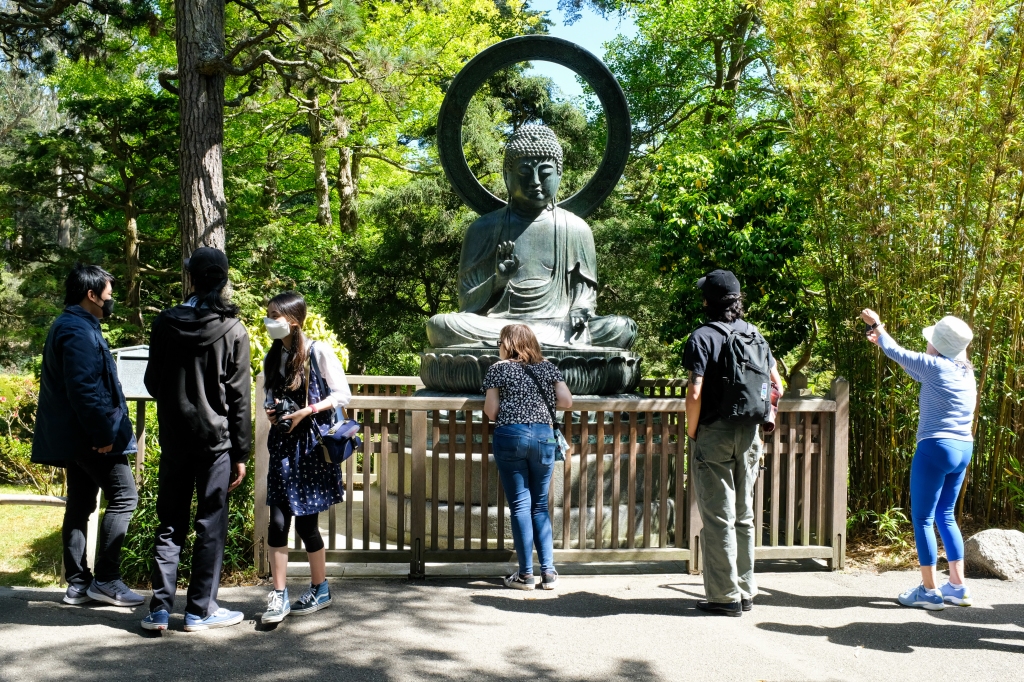By Kinen Carvala
How did a statue created 232 years ago in Japan make its way to Golden Gate Park in 1949?
The statue of Buddha in Golden Gate Park depicts the founder of the Buddhist religion, who developed a following while teaching and walking around what is modern-day Nepal and north India roughly 2500 years ago.

According to Buddhist lore, the prince Siddhartha Gautama was raised in luxury but was shocked by the suffering he encountered outside the palace. After renouncing his royal life at age 29, he attempted to understand suffering by following various teachers and later living on minimal food and without shelter. These attempts were unsuccessful, according to the David Grubin’s PBS documentary film. After resolving to meditate under a fig tree until he understood, Siddhartha became enlightened, gaining the title “Buddha.” He taught the Four Noble Truths about the nature of suffering and the Eightfold Path of how to be liberated from that suffering to reach nirvana. The Buddha gave sermons for decades before dying around the age of 80.
Buddhism spread along the Silk Road trade route to East Asia. Buddhism not only spread to East Asia, but also to Sri Lanka (off the coast of southern India) and Southeast Asian countries, including Myanmar, Thailand and Laos.
When Buddhism reached Japan, it encountered native religious traditions broadly labeled “Shintō.” The oldest Buddhist sculpture (the Asuka Daibutsu) in Japan dates back to 609 A.D. The collection of parables known as the “Lotus Sutra” is particularly esteemed within Japanese Buddhism. A vegetarian diet including soy and soup named shōjin ryōri became popular among Japanese Buddhist monks, following the Buddhist principle of abstaining from killing.
The bronze Buddha statue in Golden Gate Park was cast in 1790 for the Taionji Temple in the former Japanese province of Tajima, roughly 300 miles west of Tokyo. At the time, Japan was isolationist, with rare contact with Westerners. Military leaders in the Tokugawa shogunate wielded practical political power in Japan, with the Emperor merely maintaining his title only.

Japanese isolationism ended in 1853, when American Commodore Matthew Perry with U.S. Navy warships sailed into Tokyo Bay to open up Japan for foreign relations and trade. Opposition to the Tokugawa shogunate which used the slogan “Revere the Emperor, expel the barbarians” culminated in civil war where pro-imperial forces overthrew the Tokugawa shogunate, and the Emperor of Japan regained effective political power from the resulting Meiji Restoration of 1868. A Shintō-influenced state ideology of a divine emperor was established, and Buddhism was attacked as preventing Japan’s modernization, leading many temples to close and have their statues removed, according to Donald S. Lopez’s guide to the Lotus Sutra.
The Park’s Buddha statue passed between Japanese collectors’ hands before eventually being bought by an American. S.&G. Gump’s, a downtown luxury department store founded in San Francisco in 1861, bought the bronze Buddha statue in 1928 for display in its store before donating the statue (valued at $15,000 at the time) to the City on Feb. 24, 1949, according to the SF Chronicle. This bronze statue replaced a wooden Buddha statue in Golden Gate Park destroyed by vandals. (The Gump’s store later got a wooden Buddha statue for its store.) Gump’s closed its San Francisco store in 2018, but a new Gump’s owner opened a nearby small pop-up store in 2019, according to an SF Chronicle article from Oct. 3, 2019.
The Buddha in the Park is depicted as sitting on a lotus petal base. The Buddha is said to have compared himself to a lotus; enlightened beings are unsmeared by the world they are born into, just as lotus emerge unblemished from the ground. The short hair on the statue alludes to the Buddha’s renouncing his princely life and cutting his hair, according to Cristina Richie. The urna forehead dot represents wisdom, according to the Penn Museum Long earlobes on Buddha statues may reflect the Buddha being born with long ears after his mother dreamt of an elephant while pregnant, according to curator Madhuvanti Ghose at the Art Institute in Chicago. The Buddha’s right hand with palm facing out and fingers pointed up imparting fearlessness; the left hand with an open palm resting on the knee represents fulfilling wishes, according to the Po Lin Monastery. The five-foot halo around the statue was broken by vandals in 1957. The halo was later replaced. The bronze statue is 10 1/2 feet tall and weighs a ton and a half, according to the San Francisco Examiner.
The Buddha statue is in the Japanese Tea Garden in the west part of the Music Concourse in Golden Gate Park. Admission to the Garden is free with proof of San Francisco residency. The Garden is open from 9 a.m. to 6 p.m. during the summer.
Categories: looking back










